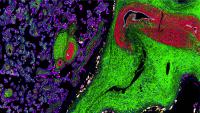Health Relevance
The adult human body is composed of tens of trillions of cells carefully organized in tissues to carry out the daily processes to keep us alive and healthy. The organization, specialization, and cooperation of different cells within each normal tissue have a profound impact on tissue growth, function, and aging. These factors can also indicate the emergence of disease. For example, immune cells reside in normal tissues as part of their regular surveillance duties. The ability to detect subtle changes in the activity of individual immune cells and in their interactions with other cells within tissues would help signal the emergence of disease before symptoms are clinically detectable.
Understanding important high-resolution features of cells in tissues remains a challenge. Recently developed technologies, including many supported through NIH programs, allow researchers to explore the organization of large numbers of cells at the individual cell level. These advances opened the possibility to study and map the organization of all cells within tissues or organs across the human body. While HuBMAP is not anticipated to map the entire body, it will get the work started, providing a framework for more complete mapping and making data available to the research community for further study.



